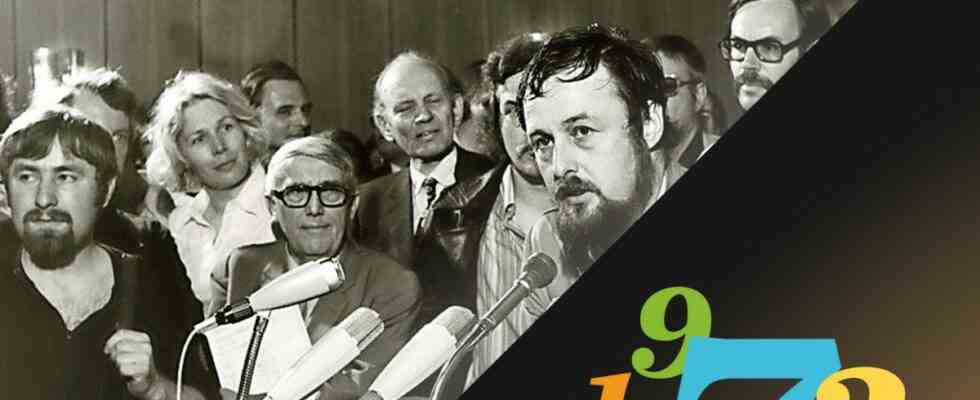If you want to describe the epochal break in art history that the fifth edition of the Documenta in Kassel means, then you have to take a close look at this picture. Not a work of art, not an exhibition hall, but a press photo in black and white, immediate as a snapshot and just as messy. Three men in ill-fitting suits can be seen beaming at the bearded Documenta curator Harald Szeemann, who is standing between them in a parka, with the electrified friendliness with which one would meet a guerrilla fighter, unsure whether a fraternity or hostage-taking is imminent. Kassel’s Lord Mayor Karl Branner, Federal Minister Lauritz Lauritzen and Documenta founder Arnold Bode do not yet know that the newcomer plans to do both.
Documenta 5, for which Szeemann was responsible, changed everything in 1972: it is not only considered the most important edition of the Documenta, but also one of the most important exhibitions of the post-war period. It is also the moment when an important large-scale German project becomes an international event for the first time.
“Spiegel” covers, Coke ads, and little pictures of saints hung on the walls
After the war, Arnold Bode was the importer of a Western concept of art that aimed at freedom and autonomy in Kassel, which had been bombed out. The importer is meant quite literally: transport crates that had been filled with abstract art in the New York Museum of Modern Art arrived in Kassel. Which he brought out perfectly in the ruins of the Fridericianum, which he effectively covered with plastic foil. And with which he stimulated the debate about abstraction and painting in post-war Germany.
From 1972 onwards, the relationship was reversed: every five years, Kassel became the center that provided the world with a new concept of art. At the time, the Federal Republic had caught up culturally, the public, especially for art, was politicized and aggressively questioned the highly subsidized cultural scene, still with the momentum of the late 1960s. It can no longer be dealt with in style discussions about international abstraction or American pop art. So what is the raison d’être of museums, exhibition halls and academies?
The title, “Questioning Reality – Image Worlds Today”, set the direction, the exhibition route left bourgeois art lovers in particular at a loss. Artists such as Jasper Johns, Marcel Broodthaers and Marcel Duchamp encountered the visual worlds of science fiction illustrators in the classicist halls of the Neue Galerie, mirror– Front covers and record covers. Charles Wilp’s posters for Afri Cola and Cinzano advertising hung on the same walls as paintings by Gerhard Richter and Franz Gertsch. There were also rosaries, statues of Mary and devotional pictures (under the heading “Imagery of piety”). Late medieval bronze figures, Blinky Palermo, Agnes Martin’s understated paintings and the highly controversial “Pictures of the Insane” section.
Joseph Beuys went to the boxing match: victory on points for art
The exhibition, which pretended to simply take a close look at the image production of a society, was one thing above all: highly political. The young Jörg Immendorff asked in the tone of a brightly colored agitprop: “For what? For whom? Ask the artists these questions – insist on the answer!”, while KP Brehmer hoisted manipulated German flags, whose colored areas of different sizes graphically represented the distribution of wealth in the Federal Republic. Edward Kienholz’ sculpture focused on the castration of a black man, while the film program not only showed Andy Warhol’s classic “Empire” but also “The Red Women’s Company”, a film about a revolutionary ballet from the People’s Republic of China.
Joseph Beuys in the office of his “Organization for Direct Democracy by Referendum”.
(Photo: Manfred Vollmer/SZ Photo)
For the first time, performers such as Rebecca Horn and Ben Vautier appeared in a large exhibition, while Fritz Schwegler walked through Kassel with his picture panels like a ballad singer and Joseph Beuys in his office of the “Organization for Direct Democracy through Referendum” in front of a vase with a red rose to visitors was waiting. At the end of the exhibition, he then competed in a boxing match in the Fridericianum against the student Abraham David Christian. The fifth Documenta ended after three rounds with art winning on points.
Before posthumous fame could set in, however, this documenta ended in a dispute over finances: Harald Szeemann had left behind a deficit for which Kassel wanted to hold him personally liable. Only after international protests from museum directors and exhibition organizers, who threatened never to work with Kassel again, was the matter dropped. What remained was initially the formula of the “Individual Mythologies”, which became the main explanation for everything in the following decades, from concept to painting – from Michael Buthe’s productions to Lothar Baumgarten’s tropical houses to Anselm Kiefer’s paintings.
But what was really epochal was the role that Harald Szeemann himself had filled with such virtuosity: the exhibition organizer or art historian who put together a show had become the “curator” who was solely responsible artistically for direction and authorship, the staging and defines the theoretical framework. And whose exhibition is more than a selection, a hanging or a thematic setting, namely a creative act.
Looking back on the year 2022 – the Documenta Fifteen, for which the Ruangrupa artist collective is responsible, is imminent – it is striking that this autocrat did not have much to do with the terms such as participation, collective and process that emerged in the early 1970s – on the contrary: “The selection can basically cannot be made from a democratic point of view at all,” wrote Szeemann himself. “In the context of art, only a subjective selection is possible. The more subjective, the better.”
Read more episodes of the column “1972: The Year That Remains”. here.

